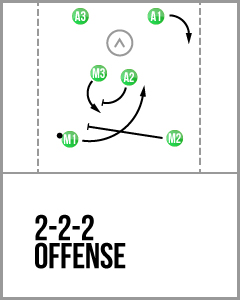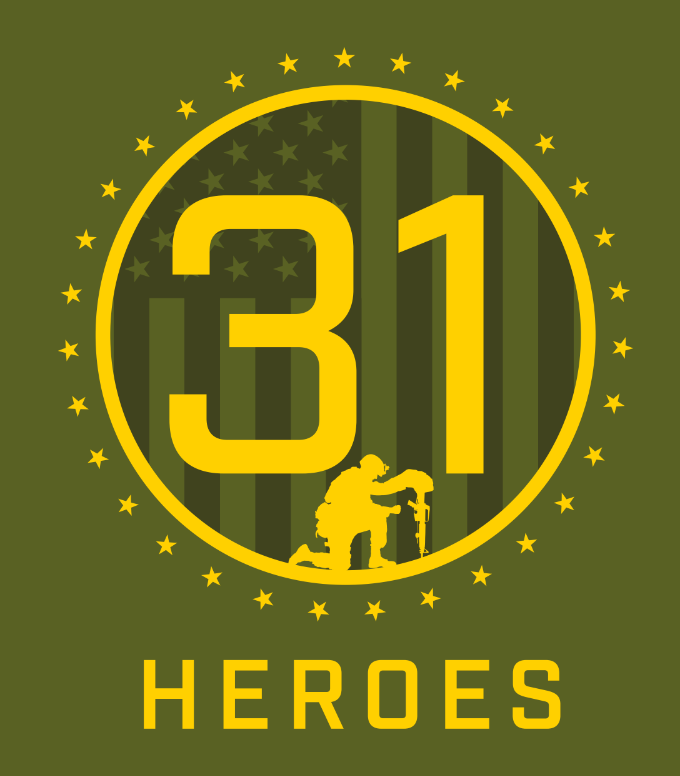Team Offense
As mentioned before, a successful offense will break a defense down into a transition situation. Proper positioning is essential to exploit these opportunities. For example, if two players bunch up near one defenseman, they allow him to defend two players at the same time. In this situation, if the ball-handling offensive player does his job and beats his man, the defense can slide and double-team without leaving a man open. Therefore it is important that the offensive players position themselves such that they are the greatest threat to the defense.
There are a number of common offensive sets that will either create scoring opportunities or insure that players are in a position to score even when teams play good defense.
PUT THE BALL IN THE BACK OF THE NET
BASIC OFFENSIVE PLAYS AND FORMATIONS
2-3-1

The first of these formations is the 2-3-1. A 2-3-1 is probably the most effective offense for spreading out the offensive players while giving them many options to create scoring opportunities. In a 2-3-1 there is one attackman behind the goal at X and one attackman just above goal line extended about ten yards from either side of the goal. There is one midfielder on the crease and two just inside the restraining box.
The 2-3-1 is an excellent formation because it teaches the fundamentals of good offensive play. The first concept that a 2-3-1 teaches is to create space for a dodge. In order to create space for the ball carrier, the adjacent player must cut through to avoid being in the way of the dodger. The next concept is the act of filling the space created by the dodging offensive player to give him an outlet. Third, it teaches when and how to become an outlet for the ball carrier if he gets in trouble. And finally, it teaches players that they need to be skilled at many different positions on the field to have a successful offense.
The simplest play out of a 2-3-1 involves the top triangle of midfielders cutting and rotating in a triangle. Similar to how a defense must play in transition, these midfielders act as though they are connected on a string. The ball carrier always controls the motion of the string. If he dodges towards another midfielder, that midfielder must move in the same direction along the triangle. And the other midfielder must replace the dodging midfielder by following him.
Similarly, the attack is also set up in a triangle and can dodge, clear through and replace in just the same manner as the midfielders do. Under ideal circumstances, one triangle will rotate in opposite directions in unison as one player dodges. The other triangle may cut and rotate as well. In this case, all of the defenders will be occupied, space is created for the ball carrier, and replacing players ensures that there are outlets to pass to if the ball carrier is under pressure. Please refer to the diagram below for a description.
When setting up the 2-3-1 rotation, it is important that the offense has a starting point. There can be a designated dodger, or a certain number of times the ball is moved around the perimeter before a dodge is made or a signal such as raising one’s arm that marks the beginning of the play. Let’s say that this person is the top right midfielder from the goalie’s view and he is dodging to his right hand, which, in this case, is a sweep across the top. Before he dodges, the adjacent top left midfielder must cut through and create space for the dodge. If both triangles are dodging, the lower left attackman must also cut through at the same time as the ball carrier begins his dodge. Next, as the dodge is taking place, the crease midfielder must replace to the area from which the dodge is made, the attackman at X fills the wing of the cutting attackman as an outlet and the opposite wing attackman follows him to X as backup for a shot. If there is no shot, the midfielder has an outlet to the attackman in front of him or can roll back and move the ball to the replacing midfielder.
2-3-1 Offense:
Triangle Offense: M1 waits for M2 and A2 to start a slow cut through. Neither M2 nor A2 should pass the front of the crease until M1 begins his dodge and picks a direction. If M1 dodges across the top, they continue the rotation and M3 replaces where M1 left a space open. A1 has backup responsibilities and A3 acts as an outlet.
Note: It is crucial that all players realize they are connected on a string. If the ball carrier is forced to change the direction of his dodge, the other offensive players must be aware of this and react properly by reversing their rotation.
Again, there are many advantages to the 2-3-1. It reinforces many of the skills that are necessary to run any offense properly: cutting through to create space, dodging to open space and replacing to become an outlet for the ball carrier to back up a shot. This offense is a simple offense to run and spaces players evenly around the goal. In time, players begin to get creative with the rotation, setting timely picks for the crease player or running two-man plays up top (recall picks, flips and fake flips). For these reasons and more, this formation is the most popular in the sport of lacrosse and offers many opportunities to players of increasing skill level.
As a coach, it is important to be patient with players when they are learning a 2-3-1. It is easy to make mistakes while learning the fundamentals of moving on a string such as when to cut through, when to replace and when to dodge. Give them time to learn this offense as they will benefit more from it than any other.
2-2-2

Another popular formation in lacrosse is the 2-2-2 inside. In this case, there are typically two attackmen behind the goal, one attackman and one midfielder on the crease and two midfielders up top. Like the 2-3-1, there is the opportunity for a two-man game up top and behind for attackmen. With the two players on the crease there is also the opportunity for off ball cutting to confuse the defense and perhaps create an open shot close to the goal.
2-2-2 Offense
2-2-2 Offense: M2 picks for M1 for a shot. M3 picks for A2 for a pop and cut. A1 gets open for an outlet for M1. If A1 gets ball, he can look for A2 cutting, M1 on a give and go, or A3 as an outlet.
The other 2-2-2 formation positions the midfielder and attackman outside of the crease in a circle. The most common play in this formation is a cut and replace in which the player adjacent to the ball cuts through and the ball carrier dodges to the goal. If a shot is not taken and no one is open, the ball is moved on and the players reset to a circle. It is also possible to set up any number of off-ball picks to open up other players. The advantage of the circle is that the defense may be confused because no one is on the crease. Likewise, offensive cutters will have more space to roam and fewer impediments in their path.
1-4-1

A formation that resembles the 2-2-2 circle is the one-four-one. In the 1-4-1 there is an attackman at X, a midfielder at point with two of the remaining players on the wings and the final two players on the crease. A common play out of this formation is the mumbo. When running a mumbo, the ball typically starts with a midfielder at point. As he prepares to dodge, the wing players cut and set picks for the crease players. The crease players run around the pick and look to receive the ball for a quick shot. If all of these players are covered and the midfielder draws a double team, there may also be a lane for the attackman at X to sneak around to the front of the goal for a quick shot. If nothing is open, the players can reset to their positions and try again. The good thing about a play like this is that it spreads the field out and only requires the offensive player to learn a simple set of instructions to run the play.
1-4-1 Offense
1-4-1 Offense: M1 dodges for shot first, feed second. A1 sneaks from behind if all options are covered. A2 and A3 should pop and fade into a passing lane off of the picks from the midfielders. If A1 gets ball behind, he should press the other side and middies and attackmen on the crease should pick and cut to get someone open.
